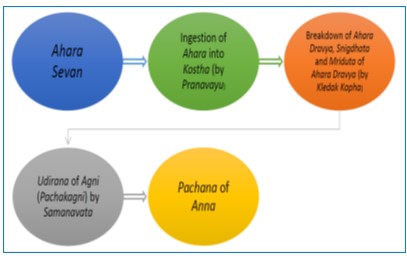Concept of Ahara Parinaman in view of Agni - A Physiological and Anatomical Review
DOI:
https://doi.org/10.21760/jaims.9.3.14Keywords:
Agni, Ahar Parinaman, Awasthapak, Grahani, Amashay, Pakwashay, KoshthaAbstract
Dosha, Dhatu and Mala are the basic elements of the body whose Source is Ahar Dravya i.e., Food is the basic source of energy for humans. Ayurveda states that our body gets it’s nutrition by Aahar Rasa. All the thirteen types of Agnis works on the four types of Ahar (Ashit, Peet, Leedh, Khadit) we take and are responsible in the formation of this Aahar Rasa. The process of Ahar Parinaman is continuing from birth until death at very minute level by Jatharagni, Bhutagni and Dhatwagni. The role of Agni is of immense importance for a healthy living because when the Agni is in normal state and if the individual consumes Matravat Ahar there will be proper digestion of food which forms Dhatusamyawastha ultimately leading to longevity. Impaired Agni is the root cause of all disease.
Downloads
References
Patil Dhanashri et al., Dhatuparinama- An Ayurvedic Approach Of Metabollic Transformation, Journal Of Ayurveda And Integrated Medical Sciences, Volume-2, Issue-2,p-116.
Acharya YT, editor. Susrutha Samhitha of Susrutha with Dalhana Tika. Varanasi: Chaukhambha Orientalia; 1992. Sushrut, Sutrasthan 15/48
Shivprasad Sharma, Ashtanga Sangraha of Vriddha Vagbhata with Sasilekha Commentary of Indu. Reprint ed. Varanasi (India): Choukambha Sanskrit Series Office; 2016. Page no.508.
https://www.slideshare.net/SoniyaVetal/concept-of-agni
Shabdakalpadruma, Radhakantdev R, editors. Amar Publication Varanasi: Chaukhamba Samskrit Series. 1967:8.
Sushrut Samhita, Shastri Ambicadutt., Varanasi: Chaukhamba Sanskrit Sansthan; 2005. p. 88.
P.V.Sharma, Charaka Samhita, sutra sthan, 28/3,5, Chukhambha Orientalia Varanasi,(2011),P-226-227
P.V.Sharma, Charaka Samhita, sutra sthan,12/11, Chukhambha Orientalia Varanasi, (2011),P-84
Lad, Vasant. Textbook of Ayurveda, Volume II: A Complete Guide to Clinical Assessment. Albuquerque: The Ayurvedic Press, 2006. Print. 189-191, 200.
Charaka Samhita, Shastri K, Chaturvedi G., editors. Varanasi: Chaukhamba Bharti Academy; 2004. p. 458
Sushrut Samhita, Shastri A., editors. Varanasi: Chaukhamba Sanskrit Sansthan; 2005. p. 56.
Tripathi B, editor. Sharngadhara – Samhita of Pandit Sharngadhara Charya ‘Dipika’ hindi. Varanasi: Chaukhamba Sanskrit Sansthan; 1994. p. 41
Shastri BS, Vishya RL, editors. Bhavaprakasha of Shri Bhava Mishra, The ‘Vidyotini’ Hindi Commentary, Notes and Appendix. Varanasi: Chaukhambha Sanskrit Sansthan; 1999. p; p. 37.
K.R.Shirkantha Murthy, Ashtanghridya, sharira sthan, 3/74-76, Chowkhambha Krishnadas Academy Varanasi, (2011)p-411
P.V.Sharma, Charaka Samhita, chikitsa sthan,15/9-11, Chukhambha Orientalia Varanasi, (2011),P-250
K.R.Shirkantha Murthy, Ashtanghridya, sharira sthan, 3/57 -58, Chowkhambha Krishnadas Academy Varanasi, (2011) p-405
K.R.Shirkantha Murthy,Ashtanghridya,Sharira sthan, 3/50-56, Chowkhambha Krishnadas Academy Varanasi, (2011)p-404-405)
P.V.Sharma, Charaka Samhita, chikitsa sthan, 15/3-8, Chukhambha Orientalia Varanasi, (2011), P-249-250.
K.R.Shirkantha Murthy, Ashtanghridya,Sharira sthan, 3/59- 61, Chowkhambha Krishnadas Academy Varanasi, (2011)p-406-407
Bhangare, Archana & Lahange, Sandeep & Bhatnagar, Vikash. (2022). Concept Of Digestive System In Ayurveda.















